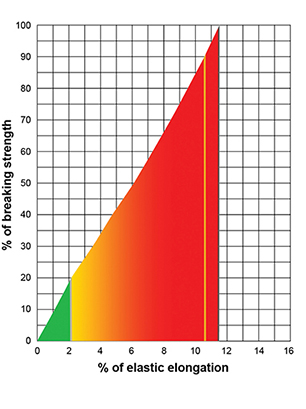Portland Braid
Rope Characteristics
Portland Braid double-braided polyester offers high value at a very competitive price. Built in the same manner as our Double Esterlon, Portland Braid offers consistent performance at an economical price.
The fiber used to produce Portland Braid is sourced from Yale’s qualified suppliers. Portland Braid can be special ordered in ultra-long continuous lengths. We also offer our optional Maxijacket urethane coating to further enhance the rope’s wear resistance.
Breaking Strengths
| Diameter (Inches) |
Weight (Lbs/100f) |
Average Spliced Break Strength* (Lbs) |
Minimum Spliced Break Strength* (Lbs) |
Maximum Working Load 5:1** (Lbs) |
|---|---|---|---|---|
| 1/4 | 2.2 | 2,440 | 2,196 | 488 |
| 5/16 | 3.5 | 3,740 | 3,366 | 748 |
| 3/8 | 5.0 | 4,990 | 4,491 | 998 |
| 7/16 | 6.3 | 7,270 | 6,543 | 1,454 |
| 1/2 | 7.9 | 10,000 | 9,000 | 2,000 |
| 9/16 | 10.0 | 12,450 | 11,205 | 2,490 |
| 5/8 | 13.0 | 15,180 | 13,662 | 3,036 |
| 3/4 | 16.4 | 18,900 | 17,010 | 3,780 |
| 7/8 | 27.1 | 31,050 | 27,945 | 6,210 |
| 1 | 36.6 | 40,320 | 36,288 | 8,064 |
| 1-1/8 | 43.5 | 52,360 | 47,124 | 10,472 |
| 1-1/4 | 54.0 | 54,600 | 49,140 | 10,920 |
| 1-1/2 | 69.2 | 67,670 | 60,903 | 13,532 |
| 1-3/4 | 103.0 | 96,000 | 86,400 | 19,200 |
| 2 | 132.0 | 125,240 | 112,716 | 25,048 |
| 2-1/4 | 155.0 | 150,000 | 135,000 | 30,000 |
| 2-1/2 | 172.6 | 168,200 | 151,380 | 33,640 |
| 2-5/8 | 220.0 | 210,000 | 189,000 | 42,000 |
| * Knots and abrupt bends significantly reduce the strength of all ropes and lower maximum working load. ** Working load is based on static or moderately dyanmic lifting/pulling operations. Instantaneous changes in load, up or down, in excess or 10% of the rope’s related working load constitute hazardous shock load and would void the normal working-load recommendation. Consult Yale Cordage for guidelines for working loads and the safe use of rope. |
||||
| Diameter (mm) |
Weight (Kg/100m) |
Average Spliced Break Strength* (kg) |
Minimum Spliced Break Strength* (kg) |
Maximum Working Load 5:1** (kg) |
|---|---|---|---|---|
| 6 | 3.3 | 1,105 | 995 | 221 |
| 8 | 5.2 | 1,695 | 1,526 | 339 |
| 10 | 7.4 | 2,265 | 2,039 | 453 |
| 11 | 9.4 | 3,300 | 2,970 | 660 |
| 13 | 11.8 | 4,540 | 4,086 | 908 |
| 14 | 14.9 | 5,650 | 5,085 | 1,130 |
| 16 | 19.4 | 6,890 | 6,201 | 1,378 |
| 19 | 24.4 | 8,580 | 7,722 | 1,716 |
| 22 | 40.4 | 14,095 | 12,686 | 2,819 |
| 25 | 54.5 | 18,305 | 16,475 | 3,661 |
| 29 | 64.8 | 23,770 | 21,393 | 4,754 |
| 32 | 80.4 | 24,785 | 22,307 | 4,957 |
| 38 | 103.0 | 30,720 | 27,648 | 6,144 |
| 44 | 153.4 | 43,580 | 39,222 | 8,716 |
| 51 | 196.6 | 56,855 | 51,170 | 11,371 |
| 57 | 230.8 | 68,100 | 61,290 | 13,620 |
| 64 | 257.0 | 76,360 | 68,724 | 15,272 |
| 67 | 327.6 | 95,340 | 85,806 | 19,068 |
| * Knots and abrupt bends significantly reduce the strength of all ropes and lower maximum working load. ** Working load is based on static or moderately dyanmic lifting/pulling operations. Instantaneous changes in load, up or down, in excess or 10% of the rope’s related working load constitute hazardous shock load and would void the normal working-load recommendation. Consult Yale Cordage for guidelines for working loads and the safe use of rope. |
||||
Rope Details
Rope Benefits
|
Elastic ElongationThe coloured area under the curve represents the rope’s energy absorption capability.
 |



